Bugbears would be sad that they get overlooked in favor of their smaller, greener cousins, the goblins. But, thankfully, bugbears don’t have the energy to care, and, worse for others involved, that just makes an adventurer that much easier to ambush.
Once that powernap of theirs is over. Oh, boy, you wait until those 80 winks are complete.
Derived from a lesser-known monster of medieval mythology, Bugbears are the bogeyman of the goblinoid race. Brutish as bears yet wily as jaguars, these tanks know not only how to sneak up on you with inherent supernatural means, but they can strike from the smallest of spaces.
Welcome to a Bugbear 5e Race Guide.
Bugbears, Goblinoid Bogeyfolk or Fluffy Brute?
Bugbears are a hulking race of goblinoid that often gets mistaken as being a closer relative to an Orc thanks to their battle prowess and intimidating stature. They gain their name from the coarse hair covering their body.
Coupled with the nails and fangs more prominent than a typical goblin’s, you’d be forgiven for mistaking them for a Werebear rather than a goblin.
While their connection to the Wylds has diminished compared to their ancestors, Bugbears still carry traits of peculiarity inherent to their bloodline. For example, a bugbear can sneak with the stealth of panthers, despite hulking through the brush like a bear.
Not even small passages will protect you, as they can fit into passages smaller than you’d ever expect without a gasp.
Tales of savage Bugbears are whispered like boogieman, for superstition tells us you never know when a Bugbear might be listening. A lumbering mountain of muscle might be wedged in a treasure chest, waiting to steal the head of the war camp’s chief as we speak!
- Bugbears are deceptively sluggish. They eat, sleep, fight, repeat. However, that doesn’t keep them from being cunning.
- Thanks to their Fey heritage, bugbears can fit in spaces one size category smaller than them without squeezing.
- Bugbears are stealthy by nature despite their size.
- While ill-tempered, they are wise enough to know when escape is the better option. As well as when to hold off escape for the right time.
- Bugbears are so macho that they have a god of cowardice to make being afraid more macho.
Bugbear Stats: Bugbear
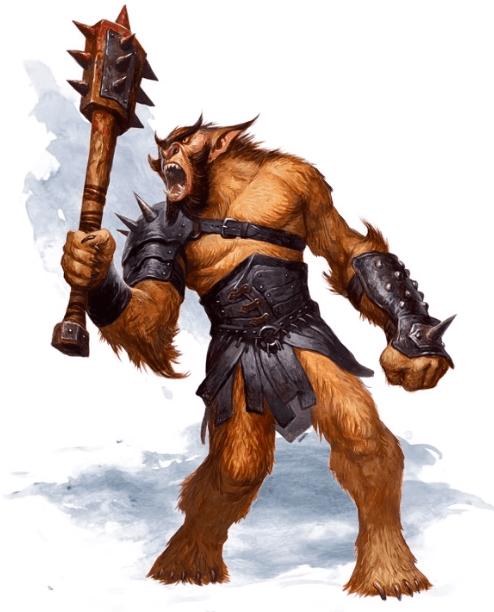
Medium humanoid (goblinoid), chaotic evil
- CR 1 (200 XP)
- Passive Perception 10
- AC: 16 (hide armor, shield) Hit Points: 27 (5d8+5)
- Speed 30 ft.
- Str: 15 (+2)
- Dex: 14 (+2)
- Con: 13 (+1)
- Int: 8 (-1)
- Wis: 11 (+1)
- Cha: 9 (-1)
- Skills: Stealth +6, Survival +2
- Senses: dark-vision 60 ft
- Languages: Common, Goblin
- Brute: An extra die of damage gets added to any melee weapon wielded by the Bugbear. (included in the damage below)
- Surprise Attack: If the Bugbear can surprise a creature and hit it in the first round of combat, they deal an extra 7 (2d6) damage from the attack.
Related read: Passive Perception 5e Guide.
Actions
- Morning Star
- Roll to Hit: +4
- Range: five feet, single target
- Hit: 11 (2d8+2) piercing
- Javelin
- Roll to Hit (Melee/Ranged):+4
- Range: 5 ft melee; 30/120 ft ranged, single target
- Hit: 9 (2d6+2) melee ; 5 (1d6+2) ranged piercing
Bugbear Chief
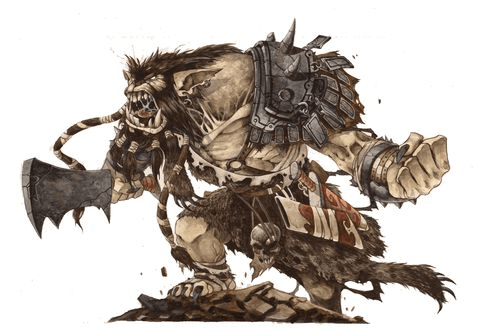
Medium humanoid (goblinoid), chaotic evil
- CR 3 (700 XP)
- Passive Perception 11
- AC: 17 (chain shirt, shield) Hit Points: 65 (10d8+20)
- Speed 30 ft.
- Str: 17 (+3)
- Dex: 14 (+2)
- Con: 14 (+2)
- Int: 11 (+0)
- Wis: 12 (+1)
- Cha: 11 (+0)
- Skills: Intimidation +2, Stealth +6, Survival +2
- Senses: dark-vision 60 ft
- Languages: Common, Goblin
- Brute: An extra die of damage gets added to any melee weapon wielded by the Bugbear. (included in the damage below)
- Surprise Attack: If the Bugbear can surprise a creature and hit it in the first round of combat, they deal an extra 7 (2d6) damage from the attack.
- Heart of Hruggek: Bugbear Chief has the advantage on saving throws against being charmed, frightened, paralyzed, poisoned, stunned, or put to sleep.
Actions
- Multiattack
- The bugbear chief makes two melee attacks.
- Morning Star
- Roll to Hit: +5
- Range: five feet, one target
- Hit: 12 (2d8+3) piercing
- Javelin
- Roll to Hit (Melee/Ranged): +4
- Range: 5 ft melee; 30/120 ft ranged, single target
- Hit: 10 (2d6+3) melee ; 6 (1d6+3) ranged piercing
BugBear Behavior
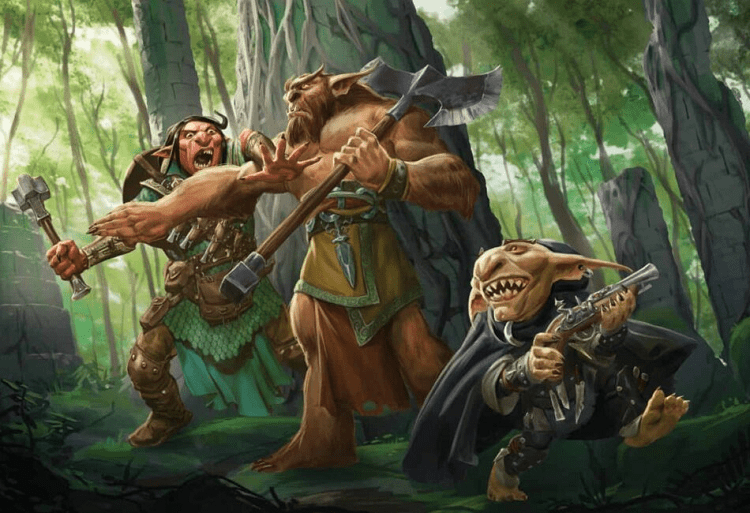
Legends of goblinoids often mistake bugbears for lazy layabouts and stupid savages. Unfortunately, this couldn’t be farther from the truth, minus that lazy part.
Bugbears are ambush predators by nature, they might be bear-like, but they have a less physical presence than their namesake, should you look at Brown Bears at least. However, admittedly their behaviors do match up.
Bugbears prefer to have the drop on their prey in all encounters. Therefore, bugbears will strike first and stomp out a problem. Their energy is conserved for these moments, but naps and food are preferred. They might have bodies resembling bears, but they are capable of dexterity and minds like a cat.
However, their wild nature hides wisdom stronger than the common creatures. So, for example, should a stronger force threaten or beat them into submission, a BugBear will find a way to escape rather than overwhelm the stronger party.
When forced to do work, they will usually bug or bully a weaker creature into doing it for them; on that note, Bugbears bully. They belligerently bully.
When it comes to Bugbear behavior, one must remember they are still goblinoids. They are, as a species, gremlins given form who skittered from the Wylds long ago. These ones are just the largest of the classic goblinoids.
They are ill-tempered and will cause chaos at the drop of a hat. Worse, you have no idea what set them off in the first place.
Bug Bear Biology
The name ‘Bug Bear’ comes from their appearance. They are the only goblinoids with body hair, which grows on them like massive tufts of coarse fur. They are far taller than most goblinoids, complete with substantial brutish figures. Their feral-leaning forms are rounded out by fangs and claws larger than their cousins.
They have wedge-shaped ears as a holdover from their fey ancestry. But unfortunately, it has been somewhat diluted thanks to generations spent disconnected from the FeyWylds. Fortunately, this gene still allows these goblinoids to creep like the wind and fit in spaces far too small despite their lumbering appearance.
Their max height is believed to be eight feet tall, and they have been found to weigh 400 pounds, mostly comprised of muscle. They walk with a hobbled, mildly hunched-over stature. They walk with the gait of a lumbering brute or troll rather than a gorilla.
The First Bugbears
There are two theories about the origin of Bug Bears.
The first belief is that Maglubiyet, battle lord and chief deity of the goblinoid, subjugated their initial Creators. Thus forcing them to unite as one under the goblinoids, where afterward, the current goblins, bugbears, and Hobgoblins were born.
Another theory believes that thanks to their history and station leading groups of goblinoids, the Hobgoblins created the goblin and Bugbear races through their tendency to breed races into slavery.
Regardless of the accepted theory, they are considered a subspecies of Hobgoblin. This lends evidence that both are actually true.
See also: Comprehensive Hobgoblin 5e Guide.
Fey Origins
They might be far enough removed to have their own creature type, but goblinoids are cousins of the Fey. Bugbears, in particular, have legends saying they came to the material from the corner of its resident’s perception, urged by a conquering God who made minions of their Pantheon.
Bug Bear Society
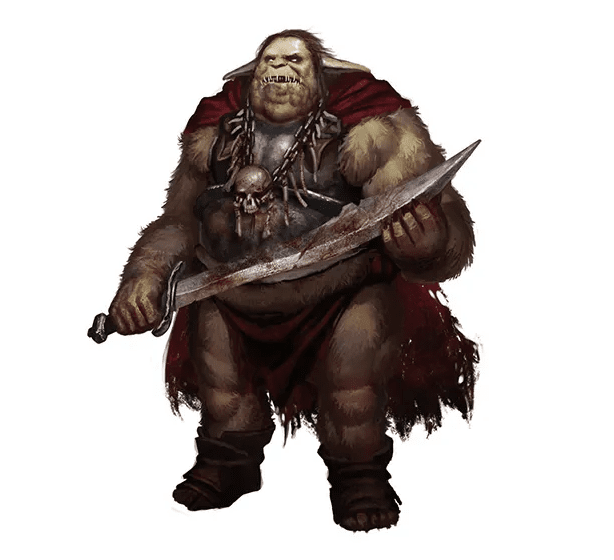
Culture, society, and tribal life are not really Bugbear concerns. They have no care nor desire to make art nor decoration that does not in some way assist them in hunting, intimidation, or stealth.
Bugbears are a rare species with no internal hierarchy. While Maglubiyet’s desire for a large army of Goblinoids will brew Bugbear battalions, they are not known for their organizational skills. Outside these notably divine circumstances, Bugbear groups function closer to gangs.
A gang of Bugbears revolves around one to two elders, these elders’ children and their mates, and their grandchildren. These family pods will have segments further connected through family ties.
Still, they will generally maintain a maximum limit of twelve members per encampment. Should things be going well, these camps can function like a well-oiled machine. A family of tight-knit gang members.
Being goblinoids, this is not as common as one might hope. When resources grow scarce through over-population of hunters or under-population of prey, a camp can become selfish and self-sabotage itself into ruin.
These groups tend to naturally splinter themselves off as, innately, a Bugbear can survive perfectly fine on its own in the wild. But, like brown bears, they physically outclass common threats to their territory or personal space.
These family pods will develop encampments around caverns and caves, only bothering to cobble makeshift shelters when they desperately need to. But, even then, they are only made with maximum ‘eh’ in mind.
The Host
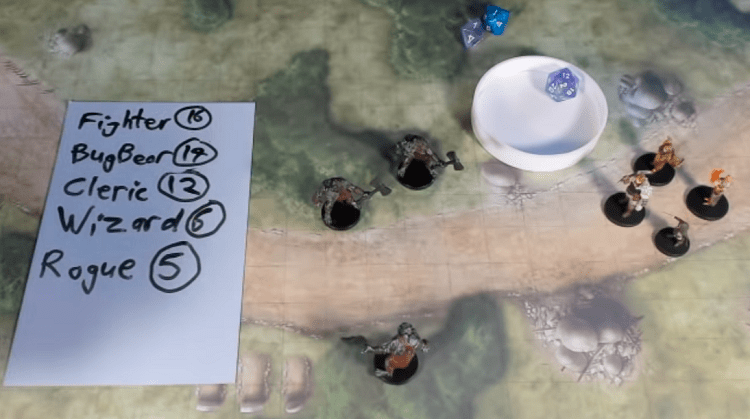
A ‘host’ can be mighty, or it can be minuscule. The significant bit is, in some form, at least one Goblin, one Bugbear, and one Hobgoblin all meet. Among all three races, there is a superstition about this very event.
Being the chief deity of all three goblinoid races, by force, Maglubiyet’s will is considered the highest force in goblinoid faith. When the three come together, they are confident this is by choice of Mag. The Goblin’s mettle, the Hobgoblin’s mind, and the Bugbear’s force combine into one unified goblinoid force.
From here, the growing group will start collecting whatever goblinoids they can find to build a mighty army of Maglubiyet’s will. Ultimately, the goal is to create a new goblinoid nation that would make a Conquering God proud.
It is actually kind of sweet if you think about it. The goblinoids conquer, hoping to make a region where they can find peace. But unfortunately, internal strife is what leads to a Host’s ruin.
To this end, a Host will act far more courteously and civilly than the average goblinoid Warband. Brutality is still in their combat, but they will also use wartime diplomacy.
For example, rather than tear a city to the ground or fully take it over, they will instead extort the city into following their rule for the cost of protection.
So long as the resources keep being supplied, the citizens of that settlement will be left in relative peace.
Proven warriors will be welcome with open arms should they prove worthy of joining Maglubiyet’s force of material might. Sadly, the faithful chosen of other deities, such as Priests and Clerics, are not so lucky. Unless their god favors them more than Malubiyet enjoys watching them suffer.
It is said that when a Host is formed, Maglubiyet closely watches every participating warrior. It is of the highest honor to be conscripted, upon death, into the might immortal army eternally fighting on the battlefield plane of Archeron.
Hosts will usually splinter by themselves over time. Even if they manage to develop a goblinoid nation where harmony can be met, this only lasts as long as the battle is won. Losses made by the Host army are considered a sign that Malubiyet has lost favor or interest in the Host, and immediately everything descends to chaos.
The Bugbears, in these situations, immediately start collecting the heads of the ones leading them as a token of respect towards Hruggek. This is almost always comprised entirely of hobgoblins. Fortunately for the Bugbears, their legions are now distracted, warring against each other once the Host has disbanded. The goblins have already left.
Bugbears in a Host
This battalion of Bugbears might have joined willingly, but they’re still Bugbears. Masters of only working when needed, most have realized that being specialists were the way to optimize downtime. Being a specialist of brutality and murder in a group of goblins generally means you are only needed for those special tortures.
Bugbears usually make their place in a host as specialized hunters, assassins, and generally anything involving their stealth specialty. Not to mention all that experience knowing how to kill something quickly to return to their interrupted nap.
Frustratingly, they still have to be bribed to do most work. Maglubiyet or not, Grankul demands those 80 winks.
Bugbear “Worship”
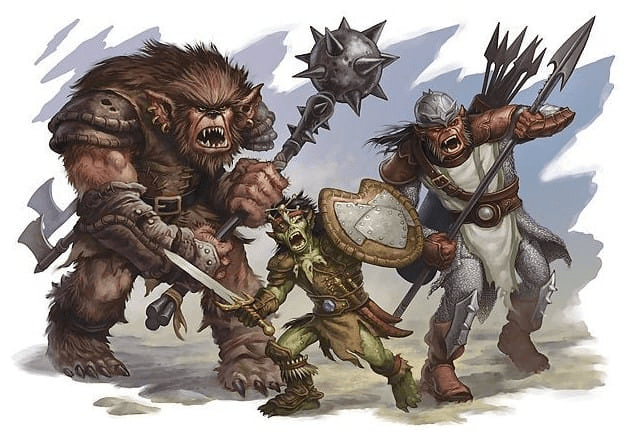
Bugbear worship is brutal and violent. Rather than use priests or clerics, all Bugbears will make an effort when they see an excellent head to harvest. Adoration to the two brothers, Hruggek and Grankhul, most commonly comes in the form of mounting the heads of worthy foes onto pikes.
Their troubles will sometimes be rewarded by their two deities in having these horrific trophies animated via divine alarm spells.
Bug Bear Pantheon
Bug Bears might lack Clerics or Priests in their society, but that is because worship of the two brother deities, Hruggek and Grankhul, comes naturally to the Bug Bears. Just as fear is inherently the cause of the recognition the goblinoid god Maglubiyet and the bugbear Bogeyman Skiggaret gain.
Worship is done through acts that please the siblings. Maglubiyet only receives ‘worship’ through Bugbear’s acceptance of his mercy to Hruggek and Grankhul. Skiggaret, however, is worshipped only through fear. Similarly, it is only done purposefully in acts of desperate fear.
Traditional worship is unfathomable to a Bugbear, as they believe the anger of their deities is shown through fundamental forces of nature.
The boom of thunder and scarcity of natural resources show their displeasure, and the only worship capable of fixing that involves brutal, calculated violence coupled with cunning survival savvy.
Maglubiyet
- Realm: Part of Archeron. Clangor is located in the first layer of the Archeron Plane called Avalas.
- Portfolio: Order and War
All goblinoids, even the Bugbear, are under the order and command of the conquering god Maglubiyet. Heroes and gods alike have fallen to the armies of Maglubiyet. He conquered the Pantheon of the three significant goblinoids to build an army of material chaos.
All who didn’t submit were destroyed, and only a few were left under what little mercy the Conquering God has. Now forced to serve as no better than generals rather than actual deities to their chosen.
What goblinoids were before Maglubiyet and who those gods were are said to be lost. A god needs to have all belief snuffed out to truly perish, after all. To Maglubiyet, that is just one more realm to conquer.
However, the brilliance in this scheme was that ole Maggie was not just a conqueror; he was a GOD of conquering. Subjugation was not how you got bugbears on your side, so instead, he gave mercy to the brother deities of the Bugbear. The play is that he was not the conqueror of these two; they were brothers in arms now.
So the bugbears’ worship’ Maglubiyet not by seeing him as a god but as a brother to their deities who they will gladly fight for because that’s, like, their bro gods’ bro, bro.
Maglubiyet’s current goal is to defeat the Pantheon of the Orcs in Archeron. Worthy goblinoid souls are taken by him to join in this eternal battle.
Hruggek
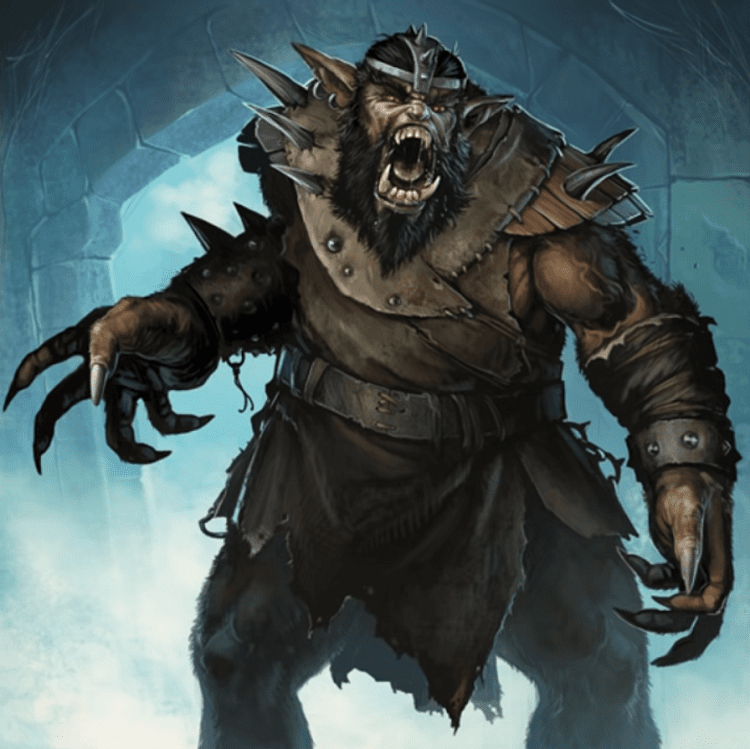
- Realm: moves between Banehold, the Barrens of Doom and Despair; the Infinite Battlefield of Acheron; and a cave in Pandemonium.
- Portfolio: Ambush, combat, violence, and War
Bugbears hold the goblinoid deity Hruggek in the highest regard, and most of these creatures can be found worshipping him as their patron. Their war-formed history and nature have led them to build the belief resembling Valhalla’s Viking myths.
The bugbears hope to prove their worth on the battlefield by collecting the most significant kill counts. By defeating as many foes as possible, they believe that their spirit will be honored by Hruggek by letting them fight at his side.
Shamans worshipping this war god were capable of achieving up to 5th level divine spells. They worshipped using blood sacrifice, given monthly on the night of a full moon. Ceremonial Hruggek garb follows the ‘cultist’ fashion tree meaning they prefer to dress in black and bone. Headpieces made of skulls were preferred.
Worship to Hruggek on the battlefield is done through decapitation of the enemy. Using the heads to decorate the battlefield in victory or taking them back to camp is up to the worshipper.
Grankhul
- Realm: Palpitatia the 241st Abyssal Layer
- Portfolio: Hunting
Grankhul is believed by the Bugbear to be the Bugbear who taught the species the art of stealth. The cunning god of hunting believes that quick and silent kills like an assassin were a wiser choice than all the resources required to raise a legion.
Bugbears seem to believe the trade-off for the gift of stealth was the necessity to sleep. Worshipers of Grankhul say that ‘sleep’ is due to the deity stealing bits of their energy, forcing the bugbears to sleep on his behalf. This allowed Grankhul to forever be vigilant.
Priests of Grankhul were generally roguish. They carried the skills of assassins and hunters and armed themselves accordingly. Their worship would grant them dark vision, as in the sensory ability, and not a prophetic hallucination. In both dress and action, priests of Grankhul are hard to pick out.
Grankhul would often test the intelligence of his priests, with the threat of blindness or death as punishment should they fail. This typically included adjusting the environment in subtle ways, expecting the Bugbear in question to fret and ponder this new development.
Worshipping Grankhul on the battlefield involved stitching the eyes of their victims open, representing the vigilant insomnia of the most paranoid patron of the bugbear Pantheon.
Skiggaret
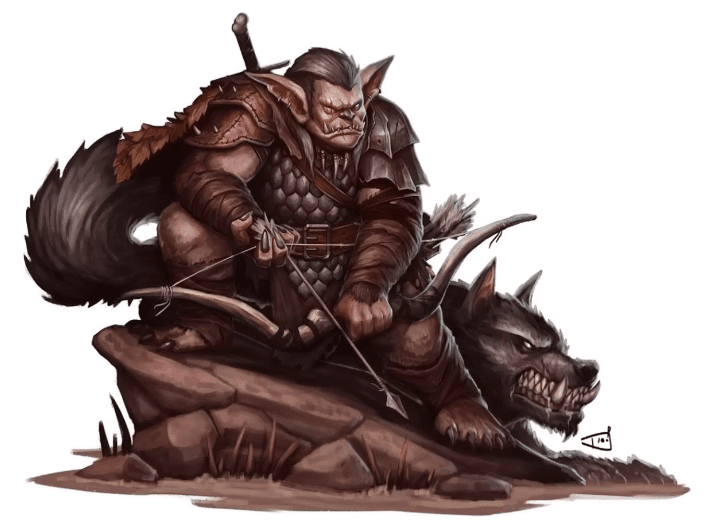
- Realm: Palpitatia the 241st Abyssal Layer
- Portfolio: Fear
No creature is considered a nightmare to the Bugbear more than Skiggaret, the bugbear boogeyman and their god of fear. Crazy, hateful, and predatory. His worshippers believe he inspires destructive and taboo acts by encouraging aggression in creatures through fear.
Skiggaret was thought of by the Bugbear as a herald of the Pantheon’s displeasure with the target. The fear a creature faced meant the disapproval of the heavens.
You only proved yourself worthy of a change of heart by standing in the face of cowardice.
In truth, no Bugbear worshipped Skiggaret, and anything relating to the worship of this being is usually done by multiracial cults and creatures hoping to bring about doom. The Bugbears believed that the very act of feeling fear was Skiggaret himself hunting you.
All the triggers and sensations of fears were considered an omen of Skiggaret hunting you, haunting you even. But fortunately, a proud goblinoid race of personal esteem like the Bug Bears do not scare lightly; the only thing they tend to fear is death itself.
Skiggaret, as such, often can be considered to represent survival instincts. Specifically, the desperation of the need to survive and all the nightmares you can bring upon your prey and yourself in doing so.
The closest thing to battlefield worship Skiggaret receives are frantic, whispered pleas for the strength to survive to the end. The most desperate will take to torturing enemies in sacrifice to this necessary evil. Such gifts are only ever given when times are truly, genuinely dire. Such as if they believe their tribe is about to be wiped out by famine or war.
The best they can hope for in these situations is that the cause becomes as fearful of Skiggaret as they are.
Playing a Bugbear
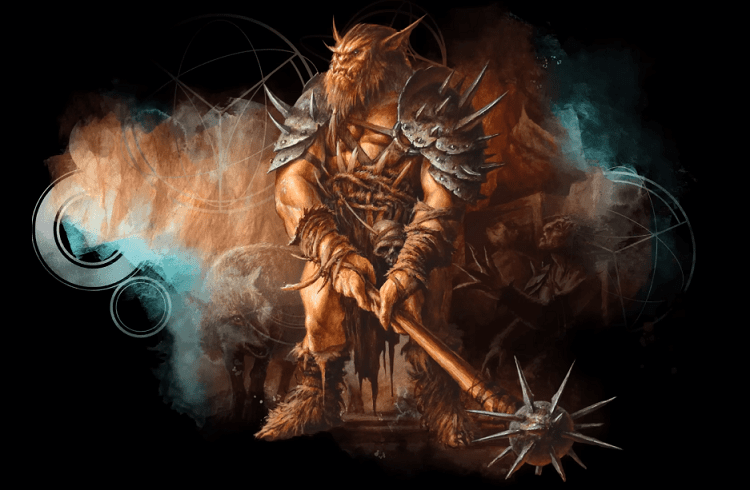
The official book ‘Mordenkainen Presents, Monsters of the Multiverse‘ includes player options for several races. This includes bugbears.
There are first some shared guidelines for creating your character as a monster. Then, to calculate higher-level character sheets, the racial fantastical race adjustments are made as you would on your first level.
- You may use three points to increase your ability scores, but you may not put all of them into one ability. At most, two points may be put into one ability and one point into another. Ability scores may not be increased beyond 20 in this manner.
- The character can read, write, and speak common as well as one other language you and your DM agree on.
- Changes to creature type, life span, height, and weight are all mentioned under the specific race. A Bugbear’s Type is Goblinoid, its size is Medium, and its walking speed is 30 feet.
- However, a Bugbear is considered a size category larger when determining carry capacity. As well as deciding feats of strengths such as pushing, lifting, or dragging.
- Bugbear players gain dark vision with a 60-foot radius.
- Their fey ancestry gives them the advantage on saves to avoid or end charmed conditions.
- Being long-limbed gives a Bugbear 5 feet of added range to melee attacks made on their turn.
- Bugbears are proficient in the sneak skill. Their fey ancestry allows them to move and stop in spaces big enough for a small-sized creature. They can fit in this space without squeezing.
- Sneak attack If a creature the bugbear attacks has not taken a turn in the current combat encounter, the assaulted enemy takes an extra 2d6 damage.
FAQs
Question: Are Bugbears Humans or Goblins?
Answer: No but Yes. The actual answer is that Bugbears are completely goblinoid. They just look like hulking humans with wedge-shaped ears.
The goblinoid races descend from the Fey Wylds, though their ancestry is diluted compared to the ones who continue to frequent it. Bugbears, Goblins, and Hobgoblins make up the three classic goblinoids.
Question: What Inspired the Bugbear of DnD?
Answer: The Bugbear is an existing mythological beast! I adore DnD thanks to its unifying multiple monsters using stats. In this case, the Bugbear is a bogeyman of Medieval England.
They took the shape of bears, aiming to frighten and eat children lingering in the forests at night. Like most bogeymen, they were invented to keep children from misbehaving and winding up bear food. A bear, for some reason, wasn’t intimidating enough.
Question: What is the Difference between a Goblin, a Hobgoblin, and a Bugbear?
Answer: A goblin is more gremlin energy than sense. They are manic little fiends that will swarm an enemy like stabby roaches. They are more cunning than they appear in caste-based tribes.
They can be considered the most internally understanding of the goblinoids as their tribes easily find a place for even the weakest goblins. Sadly, they are the least respected goblinoid by other goblinoids and the Forgotten Realms in general.
Hobgoblins, however, are far nobler in their brutality. While they believe themselves better than any other creature, they hold a strict sense of honor that makes their tribes look far more like fortified legions.
A Bugbear is a brutish survivalist who keeps the smallest communities of the bunch, acting more like stealthy, feral gangs.
Goblins are obnoxious opportunists. Hobgoblins are conquerors. Bugbears are sneaky survivalists.
Conclusion
I don’t understand why Bugbears aren’t used more in overarching fantasy. Not only do they make an interesting player option for any brutish rogues and hunters out there, but they can be a bloody surprise hidden in the DM’s monster deck.
Bugbears are capable of sneaking themselves into a crate a small goblin would. They are brutal warriors skilled at tearing your head from your body. They even will honorably mount said head on a spike to honor the brutal brothers they worship. How terribly polite of them!
Few other monsters will offer you such a noble place in their camp.
Bugbears will give your goblinoid encounters an unexpected spice of brutality, with that added stealth a goblin ambush is known for.
You never know when that fridge-sized brute will hide in a bush the size of a dog next to camp.
- Blight 5e Guide: Blood-Thirsty Brambles - August 28, 2022
- Constructs 5e Guide: Intimidating Innovation - August 20, 2022
- Modrons 5e Guide - August 13, 2022


